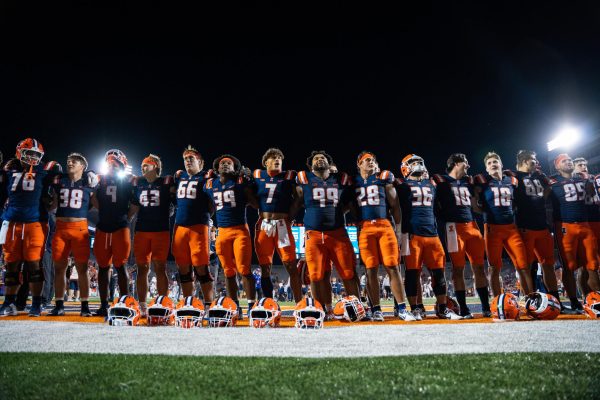UI announces spring return testing requirements for students
A student deposits saliva into a University COVID-19 test tube while taking a COVID-19 test at State Farm Center on Oct. 9.
Jan 13, 2021
On Jan. 11, Chancellor Robert J. Jones sent a Massmail detailing the University’s requirements and expectations regarding the return to campus for the spring semester.
All students must submit two negative COVID-19 tests at least three days apart between Friday and Jan. 24 before resuming all on-campus activities.
The Massmail provided a schedule for return testing based on each student’s grade level. Freshmen and new students are encouraged to test on Jan. 17 or 18, and Jan. 22. Sophomores are encouraged to test on Jan. 17 and Jan. 21. Juniors are encouraged to test on Jan. 16 and Jan. 20. Seniors and graduate students are encouraged to test on Jan. 15 and 19. Students who live in University Housing, regardless of their grade level, are encouraged to test on Jan. 17 and Jan. 21.
According to the Massmail, building access will not be granted on the Safer Illinois app until two negative tests have been submitted. Those who need building access before they are able to get two negative tests are instructed to contact their supervisors. After submitting their two negative tests, students will return to their twice-per-week testing schedules.
The Massmail also provided information regarding COVID-19 vaccinations, building access, quarantine and isolation policies, social distancing guidelines, online COVID-19 training and instructions on how to submit positive off-campus COVID-19 test results. Additionally, the Massmail notified students that they will receive an email from the Office of the Registrar later this week with instructions for submitting their spring semester residence address.
Get The Daily Illini in your inbox!
In addition to the testing sites that were open prior to winter break, the University’s testing program reopened two more testing sites on Monday: The Alice Campbell Alumni Center and the Campus Ice Arena. It is unclear which other sites will be reopened closer to the start of the spring semester.
Philip Hu, freshman in Engineering, plans to return back to campus for the spring semester. Despite having to change the date he planned to move back to campus from his home in Idaho, Hu thinks the two negative test policy will be beneficial to keeping the campus community safe.
“I think it’s a very reasonable policy, given that COVID is basically out of control anywhere outside of campus,” Hu said. “It’s not a big ask that we test negative twice. (An increase in COVID cases) is expected now we’re having more interactions indoors, so it should be expected that COVID cases might spike when we start the semester.”
Rebecca Lee Smith, associate professor in the College of Veterinary Medicine, is the lead epidemiologist on the University’s SHIELD team. Smith helped design the policy requiring two negative tests prior to starting in-person classes to combat the issues that arise with the disease’s latency period — the period where an individual is infected but is not yet infectious or detectible by test.
“The latency period is generally two to three days; if we test you today and you’re negative, that doesn’t mean you’re not infected,” Smith said. “It either means you’re not infected, or you’re in the latency period. If you were infected yesterday, you will test negative today — we know that for sure. The reason for two negative tests three days apart is that anybody that’s in the latency period for the first test will have left the latency period by the time (they take) the second test.”
The fall semester saw a large spike in COVID-19 cases the week after classes begun. Starting the Saturday before classes begun, campus saw 1,338 positive COVID-19 tests, with an average positivity rate of 1.1%, during the first two weeks of the semester. While it’s expected to see a spike in cases with an influx of students returning to campus, Smith hopes that students will monitor their socialization and limit their amount of contacts to minimize the spike.
“The first couple of weeks after students come back to town, we’re asking them to be extremely cautious to limit socialization as much as possible,” Smith said. “Keep it outdoors, keep it distanced, keep it masked, and get onto (your) testing schedules. That’s the best way we can avoid a big spike. We will see a spike, just because of the spread that’s going on throughout the country, but if people can follow our guidelines and just know that this is a really high-risk period, then hopefully we can avoid a repeat of the beginning of the fall semester. You’re only as safe as your riskiest contact.”






